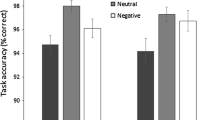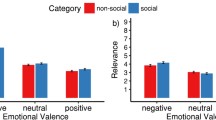Abstract
Psychological studies have already proven a connection between emotional stimuli and visual attention. However, there is a lack of evidence of how much an individual’s mood influences visual information processing of emotionally neutral stimuli. In contrast to prior studies, we explored the effect of positive mood on bottom-up low-level visual saliency. In our extensive experimental studies, we induced positive or neutral emotions in 106 subjects using a psychological method of autobiographical memories and listening to positive music and then performed an eye-tracking study with three task types—free viewing, memorizing the image content and visual search tasks. We explored differences in the human gaze behaviour between both emotions and relate them to the bottom-up attention correlation between emotionally aroused and non-aroused subjects. We observed that positive emotions induce a strong broadening and engagement effect on the bottom-up attention while performing all task types. On the other hand, we found out that certain tasks are solved less efficiently when experiencing a positive mood. Therefore, we claim that positive mood may also act as a distractor while performing certain types of tasks.










Similar content being viewed by others
Notes
Tobii X2-60 specification available online on January 2020 at: https://www.tobiipro.com/siteassets/tobii-pro/user-manuals/tobii-pro-x2-60-eye-tracker-user-manual.pdf/?v=1.0.3.
References
Armony, J.L., Dolan, R.J.: Modulation of spatial attention by fear-conditioned stimuli: an event-related fmri study. Neuropsychologia 40(7), 817–826 (2002)
Barbot, A., Carrasco, M.: Emotion and anxiety potentiate the way attention alters visual appearance. Sci. Rep. 8(1), 5938 (2018)
Becker, M.W., Leinenger, M.: Attentional selection is biased toward mood-congruent stimuli. Emotion 11(5), 1248 (2011)
Borji, A., Itti, L.: State-of-the-art in visual attention modeling. IEEE Trans. Pattern Anal. Mach. Intell. 35(1), 185–207 (2013)
Borji, A., Itti, L.: Cat2000: a large scale fixation dataset for boosting saliency research. arXiv preprint arXiv:1505.03581 (2015)
Bradley, M.M., Lang, P.J.: Measuring emotion: the self-assessment manikin and the semantic differential. J. Behav. Ther. Exp. Psychiatry 25(1), 49–59 (1994)
Bylinskii, Z., Judd, T., Oliva, A., Torralba, A., Durand, F.: What do different evaluation metrics tell us about saliency models? arXiv preprint arXiv:1604.03605 (2016)
Bylinskii, Z., Judd, T., Oliva, A., Torralba, A., Durand, F.: What do different evaluation metrics tell us about saliency models? IEEE Trans. Pattern Anal. Mach. Intell. 41(3), 740–757 (2018)
Ding, X., Huang, L., Li, B., Lang, C., Hua, Z., Wang, Y.: A novel emotional saliency map to model emotional attention mechanism. In: International Conference on Multimedia Modeling, pp. 197–206. Springer, Berlin (2016)
Egermann, H., Fernando, N., Chuen, L., McAdams, S.: Music induces universal emotion-related psychophysiological responses: comparing Canadian listeners to Congolese Pygmies. Front. Psychol. 5, 1341 (2015)
Eysenck, M.W., Keane, M.T.: Cognitive Psychology: A Student’s Handbook. Psychology Press, London (2013)
Fan, S., Jiang, M., Shen, Z., Koenig, B.L., Kankanhalli, M.S., Zhao, Q.: The role of visual attention in sentiment prediction. In: Proceedings of the 25th ACM International Conference on Multimedia, pp. 217–225 (2017)
Fan, S., Shen, Z., Jiang, M., Koenig, B.L., Xu, J., Kankanhalli, M.S., Zhao, Q.: Emotional attention: a study of image sentiment and visual attention. In: Proceedings of the IEEE Conference on Computer Vision and Pattern Recognition, pp. 7521–7531 (2018)
Ferrer, R.A., Stanley, J.T., Graff, K., Klein, W.M., Goodman, N., Nelson, W.L., Salazar, S.: The effect of emotion on visual attention to information and decision making in the context of informed consent process for clinical trials. J. Behav. Decis. Mak. 29(2–3), 245–253 (2016)
Fredrickson, B.L.: The broaden-and-build theory of positive emotions. Philos. Trans. R. Soc. B Biol. Sci. 359(1449), 1367 (2004)
Fredrickson, B.L., Branigan, C.: Positive emotions broaden the scope of attention and thought-action repertoires. Cogn. Emot. 19(3), 313–332 (2005)
Goldstein, E.B.: Encyclopedia of Perception, vol. 1. Sage, London (2010)
Grol, M., Koster, E.H., Bruyneel, L., De Raedt, R.: Effects of positive mood on attention broadening for self-related information. Psychol. Res. 78(4), 566–573 (2014)
Harel, J., Koch, C., Perona, P.: Graph-based visual saliency. In: Advances in Neural Information Processing Systems, pp. 545–552 (2007)
Holmes, E., Hackmann, A.: A healthy imagination? Editorial for the special issue of memory: mental imagery and memory in psychopathology. Memory 12(4), 387–388 (2004)
Hsu, J.L., Zhen, Y.L., Lin, T.C., Chiu, Y.S.: Affective content analysis of music emotion through eeg. Multimed. Syst. 24(2), 195–210 (2018)
Jefferies, L.N., Smilek, D., Eich, E., Enns, J.T.: Emotional valence and arousal interact in attentional control. Psychol. Sci. 19(3), 290–295 (2008)
Jiang, J., Scolaro, A.J., Bailey, K., Chen, A.: The effect of music-induced mood on attentional networks. Int. J. Psychol. 46(3), 214–222 (2011)
Judd, T., Durand, F., Torralba, A.: A benchmark of computational models of saliency to predict human fixations. In: MIT Technical Report (2012)
Karim, J., Weisz, R., Rehman, S.U.: International positive and negative affect schedule short-form (I-PANAS-SF): testing for factorial invariance across cultures. Procedia Soc. Behav. Sci. 15, 2016–2022 (2011)
Kaspar, K., Gameiro, R.R., König, P.: Feeling good, searching the bad: positive priming increases attention and memory for negative stimuli on webpages. Comput. Hum. Behav. 53, 332–343 (2015)
Killgore, W.D., Yurgelun-Todd, D.A.: Positive affect modulates activity in the visual cortex to images of high calorie foods. Int. J. Neurosci. 117(5), 643–653 (2007)
Krahé, B., Bieneck, S.: The effect of music-induced mood on aggressive affect, cognition, and behavior 1. J. Appl. Soc. Psychol. 42(2), 271–290 (2012)
Lang, P.J., Kozak, M.J., Miller, G.A., Levin, D.N., McLean Jr., A.: Emotional imagery: conceptual structure and pattern of somato-visceral response. Psychophysiology 17(2), 179–192 (1980)
Lin, T.Y., Maire, M., Belongie, S., Hays, J., Perona, P., Ramanan, D., Dollár, P., Zitnick, C.L.: Microsoft coco: common objects in context. In: European Conference on Computer Vision, pp. 740–755. Springer, Berlin (2014)
Liu, H., Xu, M., Wang, J., Rao, T., Burnett, I.: Improving visual saliency computing with emotion intensity. IEEE Trans. Neural Netw. Learn. Syst. 27(6), 1201–1213 (2016)
Maekawa, T., Anderson, S.J., de Brecht, M., Yamagishi, N.: The effect of mood state on visual search times for detecting a target in noise: an application of smartphone technology. PLoS ONE 13(4), e0195865 (2018)
Mills, C., D’Mello, S.: On the validity of the autobiographical emotional memory task for emotion induction. PLoS ONE 9(4), e95837 (2014)
Miyazawa, S., Iwasaki, S.: Effect of negative emotion on visual attention: automatic capture by fear-related stimuli. Jpn. Psychol. Res. 51(1), 13–23 (2009)
Most, S.B., Smith, S.D., Cooter, A.B., Levy, B.N., Zald, D.H.: The naked truth: positive, arousing distractors impair rapid target perception. Cogn. Emot. 21(5), 964–981 (2007)
Öhman, A., Flykt, A., Esteves, F.: Emotion drives attention: detecting the snake in the grass. J. Exp. Psychol. Gen. 130(3), 466 (2001)
Olivers, C.N., Nieuwenhuis, S.: The beneficial effect of concurrent task-irrelevant mental activity on temporal attention. Psychol. Sci. 16(4), 265–269 (2005)
Olsen, A.: The Tobii I-VT Fixation Filter. Tobii Technology, Stockholm (2012)
Pêcher, C., Lemercier, C., Cellier, J.M.: Emotions drive attention: effects on driver’s behaviour. Saf. Sci. 47(9), 1254–1259 (2009)
Phelps, E.A., Ling, S., Carrasco, M.: Emotion facilitates perception and potentiates the perceptual benefits of attention. Psychol. Sci. 17(4), 292–299 (2006)
Ramanathan, S., Katti, H., Sebe, N., Kankanhalli, M., Chua, T.S.: An eye fixation database for saliency detection in images. In: Daniilidis, K., Maragos, P., Paragios, N. (eds.) Computer Vision—ECCV 2010, pp. 30–43. Springer, Berlin (2010)
Rowe, G., Hirsh, J.B., Anderson, A.K.: Positive affect increases the breadth of attentional selection. Proc. Natl. Acad. Sci. 104(1), 383–388 (2007)
Smilek, D., Enns, J.T., Eastwood, J.D., Merikle, P.M.: Relax! Cognitive strategy influences visual search. Vis. Cogn. 14(4–8), 543–564 (2006)
Sutherland, M.R., McQuiggan, D.A., Ryan, J.D., Mather, M.: Perceptual salience does not influence emotional arousal’s impairing effects on top–down attention. Emotion 17(4), 700 (2017)
Talarico, J.M., Berntsen, D., Rubin, D.C.: Positive emotions enhance recall of peripheral details. Cogn. Emot. 23(2), 380–398 (2009)
Tsujimura, A., Miyagawa, Y., Takada, S., Matsuoka, Y., Takao, T., Hirai, T., Matsushita, M., Nonomura, N., Okuyama, A.: Sex differences in visual attention to sexually explicit videos: a preliminary study. J. Sex. Med. 6(4), 1011–1017 (2009)
Wadlinger, H.A., Isaacowitz, D.M.: Positive mood broadens visual attention to positive stimuli. Motiv. Emot. 30(1), 87–99 (2006)
Watkins, E.R., Moberly, N.J.: Concreteness training reduces dysphoria: a pilot proof-of-principle study. Behav. Res. Ther. 47(1), 48–53 (2009)
Watson, D., Clark, L.A., Tellegen, A.: Development and validation of brief measures of positive and negative affect: the panas scales. J. Pers. Soc. Psychol. 54(6), 1063 (1988)
Xu, Y., Gao, S., Wu, J., Li, N., Yu, J.: Personalized saliency and its prediction. IEEE Trans. Pattern Anal. Mach. Intell. 41, 2975–2989 (2018)
Xu, Y., Li, N., Wu, J., Yu, J., Gao, S.: Beyond universal saliency: personalized saliency prediction with multi-task CNN. In: IJCAI, pp. 3887–3893 (2017)
Zadra, J.R., Clore, G.L.: Emotion and perception: the role of affective information. Wiley Interdiscip. Rev. Cogn. Sci. 2(6), 676–685 (2011)
Author information
Authors and Affiliations
Corresponding author
Additional information
Publisher's Note
Springer Nature remains neutral with regard to jurisdictional claims in published maps and institutional affiliations.
The authors would like to thank for financial contribution from UVP Project STU and from the Research and Development Operational Programme for the Project “University Science Park of STU Bratislava”, ITMS 26240220084, co-funded by the European Regional Development Fund and Grant VEGA 1/075/19 2019–2022.
Rights and permissions
About this article
Cite this article
Laco, M., Polatsek, P., Dekrét, Š. et al. Effects of individual’s emotions on saliency and visual search. Vis Comput 37, 1581–1592 (2021). https://doi.org/10.1007/s00371-020-01912-7
Published:
Issue Date:
DOI: https://doi.org/10.1007/s00371-020-01912-7




